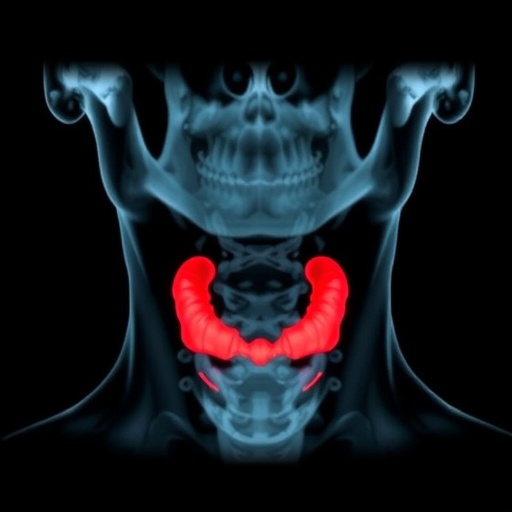In the field of thyroid surgery, protecting parathyroid gland function remains an ongoing challenge, with iatrogenic injury posing significant risks and long-term consequences for patients. A recent multicenter retrospective study published in BMC Cancer sheds new light on surgical techniques aimed at mitigating these risks. Researchers investigated the efficacy of a complete intermediate approach versus the traditional lateral approach, revealing important findings that could reshape operative strategies in thyroidectomies.
The thyroid gland and parathyroid glands occupy anatomically intimate locations within the neck, making inadvertent damage to the parathyroid glands during thyroid surgery a frequent complication. These small glands regulate calcium metabolism through parathyroid hormone (PTH) secretion, and their impairment can lead to hypoparathyroidism—a condition characterized by hypocalcemia that may be temporary or permanent. The traditional lateral approach, widely used in conventional thyroidectomies, has been the standard surgical access method but is associated with a measurable risk of parathyroid injury.
Emerging from the realm of endoscopic thyroid surgeries, the complete intermediate approach represents an alternative technique that offers a more centered and minimally invasive surgical corridor. This approach, recently adapted for traditional open surgeries as well, aims to provide better visualization and preservation of vital structures, particularly the parathyroid glands. The new study enrolled 270 patients diagnosed with papillary thyroid cancer who underwent total thyroidectomy across three different medical centers between 2020 and 2022.
One remarkable aspect of this research lies in its comprehensive patient population and rigorous monitoring of parathyroid function. Each patient’s preoperative and postoperative parameters, including PTH levels, serum calcium, tumor size, lymphatic dissection range, and operation duration, were meticulously recorded and analyzed. Importantly, long-term parathyroid function was closely followed for six months post-surgery to differentiate transient hypoparathyroidism from permanent gland dysfunction.
The comparative groups consisted of an observation group, operated on using the complete intermediate approach, and a control group, which underwent the conventional lateral approach. Baseline preoperative parathyroid hormone and serum calcium levels were comparable across both groups, ensuring a balanced assessment of postoperative outcomes. The initial postoperative day revealed a statistically significant preservation of parathyroid function in patients treated with the intermediate approach. These patients exhibited notably higher PTH and serum calcium levels, indicating reduced inadvertent gland injury.
Beyond early postoperative improvements, the study’s longitudinal follow-up underscored the clinical relevance of the intermediate approach. At both three and six months, all patients in the intermediate approach group maintained normal parathyroid hormone levels, signifying functional preservation of the parathyroid glands. In stark contrast, the control group experienced cases of persistent hypoparathyroidism, with four patients demonstrating reduced PTH levels indicative of permanent gland damage.
This evidence positions the complete intermediate approach as a compelling alternative to traditional methods, highlighting its potential to safeguard parathyroid integrity during thyroidectomy. The implications for surgical practice are profound—as permanent hypoparathyroidism can result in lifelong dependency on calcium and vitamin D supplementation, with associated morbidity and quality of life detriments. Reducing this risk translates to enhanced patient safety and improved postoperative outcomes.
Technical advantages underlying the intermediate approach include improved anatomical exposure and limited tissue trauma. By navigating through the midline and carefully dissecting the tracheoesophageal area, surgeons can more readily identify and preserve the parathyroid glands and their delicate vascular supply. This contrasts with the lateral approach, where the surgical field may offer less optimal visualization, increasing the risk of gland devascularization and inadvertent excision.
The study also reinforces the importance of multidisciplinary collaboration and high surgical expertise in thyroid operations. Conducted across multiple centers, the research validates the reproducibility and generalizability of the intermediate approach. It further suggests that surgical training programs might consider incorporating this technique to optimize patient safety profiles and functional outcomes.
Given the growing incidence of papillary thyroid cancer worldwide, refinements in surgical techniques remain critical to advancing endocrine oncology care. This study contributes to a growing body of literature advocating for precision surgery that transcends tumor excision alone, extending into preservation of organ function and quality of life. The complete intermediate approach exemplifies this paradigm shift, merging oncologic efficacy with meticulous anatomical stewardship.
Furthermore, the findings align well with trends toward minimally invasive procedures and enhanced recovery protocols. Although traditionally associated with endoscopic surgeries, innovations like the intermediate approach represent the convergence of endoscopic benefits with conventional open surgery practicality, offering incremental improvements without the need for specialized instrumentation.
While retrospective by design, the study’s robust sample size and methodical follow-up metrics lend credibility to its conclusions. Future prospective randomized controlled trials could further validate these results and investigate additional endpoints such as patient-reported outcomes and cost-effectiveness analyses. Nonetheless, the current findings mark a significant step toward safer thyroid surgery.
In conclusion, this multicenter observational study provides compelling evidence favoring the complete intermediate approach for thyroidectomy in patients with papillary thyroid cancer. By prioritizing parathyroid gland preservation, the technique reduces the incidence of hypoparathyroidism and its attendant complications. Surgeons and healthcare institutions should critically evaluate this approach within their clinical protocols to enhance patient-centered care, potentially reducing the burden of iatrogenic parathyroid injury on a global scale.
The study’s outcomes not only affirm the value of surgical innovation but also underscore the importance of detailed anatomical knowledge and technical precision. As thyroid surgery continues to evolve, such evidence-based modifications will be vital for optimizing both treatment efficacy and quality of life for affected patients worldwide.
Subject of Research: Protection of parathyroid function during thyroid surgery
Article Title: Protection of parathyroid function during thyroid surgery with a complete intermediate approach: a retrospective multicenter observational study
Article References:
Yuan, J., Gu, J., Ding, M. et al. Protection of parathyroid function during thyroid surgery with a complete intermediate approach: a retrospective multicenter observational study. BMC Cancer 25, 1309 (2025). https://doi.org/10.1186/s12885-025-14690-z
Image Credits: Scienmag.com




